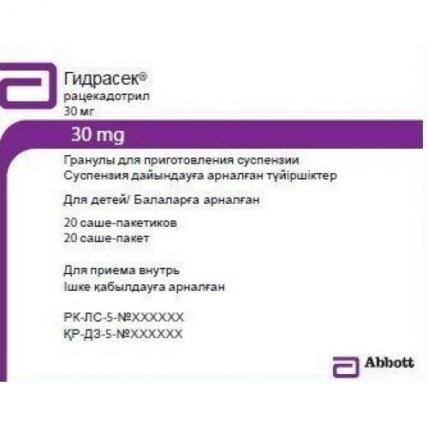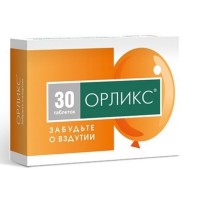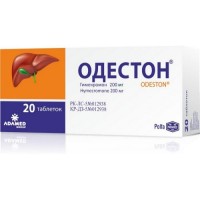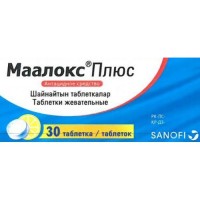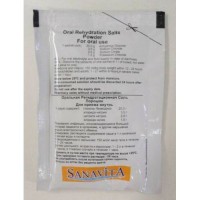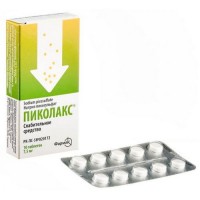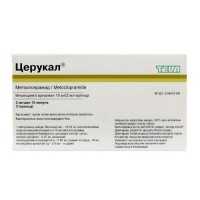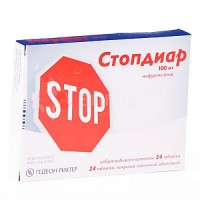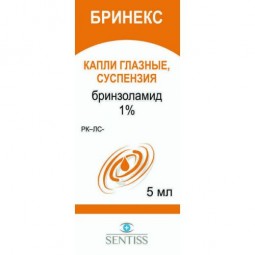Gidrasek 16's 30 mg granules for oral suspension
- $14.90
The trade name
Gidrasek ®
the International unlicensed
name Ratsekadotril Lekarstvennaya
the Granule form for preparation of suspension for intake, 10 mg and 30 mg
Structure
of One sachet - a bag contains
active agent – ratsekadotrit 10 mg or 30 mg,
excipients: sucrose, silicon dioxide colloidal anhydrous, polyacrylate dispersion of 30% (Eudrazhit® of NE 30 D), apricot fragrance (No. 6 Polvaromas-IFF).
The description
Powder of white color with a characteristic apricot smell.
Pharmacotherapeutic group
Antidiarrheal drugs. Other anti-diarrheal drugs. Ratsekadotril.
ATX A07XA04 code
Pharmacological
Pharmacokinetics Absorption properties. At intake ratsekadotrit quickly it is soaked up. Its pharmacological action on inhibition of an enkefalinaza of plasma begins in 30 minutes. The bioavailability of a ratsekadotril does not change at meal, but the peak activity comes later approximately on an hour and a half.
Distribution. In blood plasma, after use of the ratsekadotril marked with radioactive isotope 14C, the content of radio carbon was many times higher, than in blood cells, and 3 times above, than in whole blood. Thus, drug slightly contacts blood cells. Radio carbon is moderately distributed in other body tissues what the seeming volume of its distribution in plasma in the amount of 66.4 kg testifies to. About 90% of an active metabolite of a ratsekadotril, a tiorfan – (RS) - N-okco-2-(mercaptomethyl) - 3-fenilpropit) glycine, contacts plasma proteins, mainly, with albumine. Pharmacokinetic properties of a ratsekadotril do not change at reception of repeated doses and prescribing of drug to patients of advanced age.
Duration and expressiveness of action of a ratsekadotril are dose-dependent. Time of achievement of the maximum activity on plasma enkefalinaza inhibition at children is about 2 hours and there correspond 90% to suppression of activity at a dose of 1.5 mg/kg. At adults time to peak inhibition of an enkefalinaza of plasma is about 2 hours and there correspond 75% to suppression of activity at reception of a dose of 100 mg.
At a dose of 100 mg the inhibition of an enkefalinaza of plasma lasts about 8 hours.
Metabolism. Time of biological semi-removal measured by plasma enkefalinaza inhibition duration, about 3 hours.
Ratseakdotril is quickly hydrolyzed in (RS) - N-okco-2-(mercaptomethyl) - 3-fenilpropit) glycine, an active metabolite which, in turn, is transformed to inactive metabolites. Repeated reception of a ratsekadotril does not cause cumulation in an organism.
The data obtained as a result of the researches in vitro show that ratsekadotril/triorfan and four main inactive metabolites do not inhibit a CYP enzyme isoform (3A4, 2D6. 2C9, 1A2 and 2S19) in degree which can be clinically significant.
The data obtained as a result of the researches in vitro show that ratsekadotril/triorfan and four main inactive metabolites do not induce an isoform of CYP enzyme (3A, 2A6, 2V6, 2S9/2C19, 1 A, 2E1) and the conjugated enzymes uridine of a glyukuronoziltransferaza (UGTs) in degree which can be clinically significant.
Ratsekadotril does not influence extent of linking with proteins of plasma of active agents which to a large extent contact proteins of plasma, such as tolbutamide, warfarin, niflumovy acid, digoxin and Phenytoinum.
At patients with a liver failure (cirrhosis, class B on Chayld-Pyyu) the following features of a pharmacokinetic profile of an active metabolite of a ratsekadotril in comparison with healthy faces were revealed: similar values of time of achievement of the maximum concentration (Tmax) and elimination half-life (T1/2), and value of the maximum concentration (Cmax) and the area under curve (AUC) – lower (-65% and – 29%, respectively).
At patients with a heavy renal failure (clearance of creatinine (CC) of 11-39 ml/min.) the kinetic profile of an active metabolite of a ratsekadotril showed lower maximum concentration (Cmax) (-49%) and higher values of the area under curve (AUC) (+16%) and elimination half-life (T1/2), in comparison with healthy faces which KK have more than 70 ml/min.
At children the pharmacokinetic indicators are similar to those at adults, the maximum concentration of drug in blood (Cmax) is reached 2 hours 30 min. later after use.
Signs of accumulation after repeated use of drug every 8 hours within 7 days were not observed.
Removal. Ratsekadotril is brought mainly in the form of inactive metabolites with urine and also in small amounts with excrements. Removal through lungs is insignificant.
The pharmacodynamics
Ratsekadotril is inactive substance, as a result of hydrolysis he turns in tiorfan which has property to inhibit an enkefalinaza, the peptidase of a cellular membrane localized in various fabrics, especially in epithelial cells of a small intestine. This enzyme participates in hydrolysis of exogenous peptides and splitting of endogenous peptides, such as enkephalins. Therefore, ratsekadotrit protects endogenous enkephalins which are physiologically active at the level of a digestive tract, prolonging their anti-secretory action.
Ratsekadotril represents substance with anti-secretory action, its activity is limited mucous a small intestine. It reduces the hypersecretion of water and electrolytes in a small intestine caused by cholera toxin or inflammation does not affect basal secretory activity. Ratsekadotril quickly shows antidiarrheal action, without influence on duration of intestinal transit.
Ratsekadotril does not cause an abdominal distension. In clinical trials the frequency of a secondary constipation at reception of a ratsekadotril is comparable with the group accepting placebo.
At intake its activity is shown only at the peripheral level, without impact on the central nervous system.
Indications
- as additional symptomatic therapy of acute diarrhea at children are more senior than 3 months at simultaneous carrying out oral rehydration.
Combined use with drugs for causal treatment.
The route of administration and doses
of Gidrasek® accept inside, in a combination with rehydration therapy.
Doses define according to body weight: at the rate of 1.5 mg/kg on each reception three times a day at regular intervals.
for children up to 9 kg:
one sachet (on 10 mg) 3 times a day
for children weighing 9-13 kg:
two sachets (on 10 mg) 3 times a day
for children weighing 13-27 kg:
one sachet (on 30 mg) 3 times a day
for children weighing more than 27 kg:
two sachets (on 30 mg) 3 times a day
continue Treatment before achievement of a 2-fold normal chair in day. The course of treatment should not exceed 7 days.
Long therapy ratsekadotrily is not recommended.
The granule can be added to food, to part in a small amount of water (for example, in a water teaspoon), it is good to mix and give to the child immediately.
Clinical trials with participation of babies were not conducted 3 months are younger.
Special groups of patients
did not take part children and babies with a renal and liver failure In clinical trials.
Side effects
are listed below side reactions which were observed at reception of a ratsekadotril more often than at intake of placebo, or recorded in post-marketing practice.
Infrequently (& gt, 1/1000, & lt, 1/100)
- rash, an erythema
- tonsillitis
Frequency is unknown
- a multiformny erythema, a paraglossa, a face edema, hypostasis of lips, the century, a Quincke's disease, urticaria, a knotty erythema, papular rash, a prurigo, an itching swelled.
The contraindication
- hypersensitivity to active or to any of drug excipients
- intolerance of fructose, a syndrome of glyukozo-galaktozny malabsorption or deficiency of invertase-isomaltase (drug contains sucrose)
- children's age up to 3 months of life as data on safety and efficiency do not exist
- a renal and liver failure at children irrespective of degree of manifestation, due to the lack of data on use for this group of patients
Medicinal interactions
does not exist messages about medicinal interactions of a ratsekadotril at the person Today. It is known that the concomitant use with nifuroksazidy and loperamide does not change kinetics of a ratsekadotril.
Special instructions
At treatment by Gidrasek it is necessary to observe the rehydration mode.
Rehydration is of very great importance at treatment of acute diarrhea at children till 1 year. The required volume and a way of rehydration needs to be corrected depending on age and the patient's weight and also a stage and severity of a state, especially in case of the serious or long diarrhea which is followed by severe vomiting or lack of appetite. Besides, it is important to provide regularity of food (including feedings with a breast) and reception of enough liquid.
Presence at a chair of impurity of blood or pus and/or temperature increase can indicate bacterial intestinal infection as the cause of diarrhea, or presence of other serious disease that it forms the basis for causal treatment (for example, using antibiotics) or a further research. It is not necessary to accept ratsekadotrit at such states. As additional therapy of acute bacterial diarrhea ratsekadotrit it can be applied together with antibiotics.
Due to the insufficiency of data it is not recommended to apply ratsekadotrit in the diarrhea connected with reception of antibiotics and chronic diarrhea.
At treatment of patients with diabetes it is necessary to take into account that each bag contains sucrose in the following quantities:
¿ñÓáßѬ® 10 mg: 0.966 on about one g 1 g a bag
of Гидрасек® 30 mg: 2.899 sucrose g on one 3 g a bag
If the amount of sucrose (source of glucose and fructose) in the daily number of Gidrasek of 10 mg or 30 mg exceeds 5 g, it should be considered when calculating daily consumption of sugars.
¿ñÓáßѬ® 10 mg and Гидрасек® 30 mg cannot be given to babies 3 months as data on safety and efficiency do not exist are younger. Drug also should not be given to children with a renal and liver failure irrespective of degree of manifestation, due to the lack of data on use in this group of the population.
In long vomiting the bioavailability of a ratsekadotril can be reduced.
Pregnancy and the period of a lactation
the granule Drug Gidrasek® for preparation of suspension is not intended for use for the women planning pregnancy and pregnant women. Preclinical trials did not show direct or indirect harmful effects of a ratsekadotril on a pregnancy course, development of an embryo and a fruit, a course of childbirth and a puerperal period. However in the absence of clinical data Gidrasek's reception by pregnant women is not recommended.
Гидрасек® the women nursing as has not enough data on excretion of a ratsekadotril with breast milk the person should not accept.
Features of influence of medicine on ability to run the vehicle or potentially dangerous mechanisms
Clinical trials with participation of adults showed that Gidrasek® does not influence (or influence insignificant) on ability to drive the car and to work on potentially dangerous equipment.
The overdose
does not exist messages about Gidrasek's overdose. Adults have a single dose in a dose 2 g that is equivalent to 20 therapeutic doses, did not cause negative effect.
Symptoms: strengthening of side effect is possible.
Treatment: symptomatic.
The form of release and packing
On 1 g (for a dosage of 10 mg) or on 3 g (for a dosage of 30 mg) drug place in a sachet bags from a film polyvinylchloride / polyethylene / polyvinyldichloride (PVC/PE/PVDC).
On 16 bags in a cardboard pack of the instruction for medical use in the state and Russian languages.
To Store storage conditions at a temperature not above 25 °C.
To store out of children's reach!
3 years
not to apply a period of storage after an expiration date.
Prescription status
According to the prescription
of Proizvoditel Laboratories of Sofartex, France
to Develop
Gidrasek ®
the International unlicensed
name Ratsekadotril Lekarstvennaya
the Granule form for preparation of suspension for intake, 10 mg and 30 mg
Structure
of One sachet - a bag contains
active agent – ratsekadotrit 10 mg or 30 mg,
excipients: sucrose, silicon dioxide colloidal anhydrous, polyacrylate dispersion of 30% (Eudrazhit® of NE 30 D), apricot fragrance (No. 6 Polvaromas-IFF).
The description
Powder of white color with a characteristic apricot smell.
Pharmacotherapeutic group
Antidiarrheal drugs. Other anti-diarrheal drugs. Ratsekadotril.
ATX A07XA04 code
Pharmacological
Pharmacokinetics Absorption properties. At intake ratsekadotrit quickly it is soaked up. Its pharmacological action on inhibition of an enkefalinaza of plasma begins in 30 minutes. The bioavailability of a ratsekadotril does not change at meal, but the peak activity comes later approximately on an hour and a half.
Distribution. In blood plasma, after use of the ratsekadotril marked with radioactive isotope 14C, the content of radio carbon was many times higher, than in blood cells, and 3 times above, than in whole blood. Thus, drug slightly contacts blood cells. Radio carbon is moderately distributed in other body tissues what the seeming volume of its distribution in plasma in the amount of 66.4 kg testifies to. About 90% of an active metabolite of a ratsekadotril, a tiorfan – (RS) - N-okco-2-(mercaptomethyl) - 3-fenilpropit) glycine, contacts plasma proteins, mainly, with albumine. Pharmacokinetic properties of a ratsekadotril do not change at reception of repeated doses and prescribing of drug to patients of advanced age.
Duration and expressiveness of action of a ratsekadotril are dose-dependent. Time of achievement of the maximum activity on plasma enkefalinaza inhibition at children is about 2 hours and there correspond 90% to suppression of activity at a dose of 1.5 mg/kg. At adults time to peak inhibition of an enkefalinaza of plasma is about 2 hours and there correspond 75% to suppression of activity at reception of a dose of 100 mg.
At a dose of 100 mg the inhibition of an enkefalinaza of plasma lasts about 8 hours.
Metabolism. Time of biological semi-removal measured by plasma enkefalinaza inhibition duration, about 3 hours.
Ratseakdotril is quickly hydrolyzed in (RS) - N-okco-2-(mercaptomethyl) - 3-fenilpropit) glycine, an active metabolite which, in turn, is transformed to inactive metabolites. Repeated reception of a ratsekadotril does not cause cumulation in an organism.
The data obtained as a result of the researches in vitro show that ratsekadotril/triorfan and four main inactive metabolites do not inhibit a CYP enzyme isoform (3A4, 2D6. 2C9, 1A2 and 2S19) in degree which can be clinically significant.
The data obtained as a result of the researches in vitro show that ratsekadotril/triorfan and four main inactive metabolites do not induce an isoform of CYP enzyme (3A, 2A6, 2V6, 2S9/2C19, 1 A, 2E1) and the conjugated enzymes uridine of a glyukuronoziltransferaza (UGTs) in degree which can be clinically significant.
Ratsekadotril does not influence extent of linking with proteins of plasma of active agents which to a large extent contact proteins of plasma, such as tolbutamide, warfarin, niflumovy acid, digoxin and Phenytoinum.
At patients with a liver failure (cirrhosis, class B on Chayld-Pyyu) the following features of a pharmacokinetic profile of an active metabolite of a ratsekadotril in comparison with healthy faces were revealed: similar values of time of achievement of the maximum concentration (Tmax) and elimination half-life (T1/2), and value of the maximum concentration (Cmax) and the area under curve (AUC) – lower (-65% and – 29%, respectively).
At patients with a heavy renal failure (clearance of creatinine (CC) of 11-39 ml/min.) the kinetic profile of an active metabolite of a ratsekadotril showed lower maximum concentration (Cmax) (-49%) and higher values of the area under curve (AUC) (+16%) and elimination half-life (T1/2), in comparison with healthy faces which KK have more than 70 ml/min.
At children the pharmacokinetic indicators are similar to those at adults, the maximum concentration of drug in blood (Cmax) is reached 2 hours 30 min. later after use.
Signs of accumulation after repeated use of drug every 8 hours within 7 days were not observed.
Removal. Ratsekadotril is brought mainly in the form of inactive metabolites with urine and also in small amounts with excrements. Removal through lungs is insignificant.
The pharmacodynamics
Ratsekadotril is inactive substance, as a result of hydrolysis he turns in tiorfan which has property to inhibit an enkefalinaza, the peptidase of a cellular membrane localized in various fabrics, especially in epithelial cells of a small intestine. This enzyme participates in hydrolysis of exogenous peptides and splitting of endogenous peptides, such as enkephalins. Therefore, ratsekadotrit protects endogenous enkephalins which are physiologically active at the level of a digestive tract, prolonging their anti-secretory action.
Ratsekadotril represents substance with anti-secretory action, its activity is limited mucous a small intestine. It reduces the hypersecretion of water and electrolytes in a small intestine caused by cholera toxin or inflammation does not affect basal secretory activity. Ratsekadotril quickly shows antidiarrheal action, without influence on duration of intestinal transit.
Ratsekadotril does not cause an abdominal distension. In clinical trials the frequency of a secondary constipation at reception of a ratsekadotril is comparable with the group accepting placebo.
At intake its activity is shown only at the peripheral level, without impact on the central nervous system.
Indications
- as additional symptomatic therapy of acute diarrhea at children are more senior than 3 months at simultaneous carrying out oral rehydration.
Combined use with drugs for causal treatment.
The route of administration and doses
of Gidrasek® accept inside, in a combination with rehydration therapy.
Doses define according to body weight: at the rate of 1.5 mg/kg on each reception three times a day at regular intervals.
for children up to 9 kg:
one sachet (on 10 mg) 3 times a day
for children weighing 9-13 kg:
two sachets (on 10 mg) 3 times a day
for children weighing 13-27 kg:
one sachet (on 30 mg) 3 times a day
for children weighing more than 27 kg:
two sachets (on 30 mg) 3 times a day
continue Treatment before achievement of a 2-fold normal chair in day. The course of treatment should not exceed 7 days.
Long therapy ratsekadotrily is not recommended.
The granule can be added to food, to part in a small amount of water (for example, in a water teaspoon), it is good to mix and give to the child immediately.
Clinical trials with participation of babies were not conducted 3 months are younger.
Special groups of patients
did not take part children and babies with a renal and liver failure In clinical trials.
Side effects
are listed below side reactions which were observed at reception of a ratsekadotril more often than at intake of placebo, or recorded in post-marketing practice.
Infrequently (& gt, 1/1000, & lt, 1/100)
- rash, an erythema
- tonsillitis
Frequency is unknown
- a multiformny erythema, a paraglossa, a face edema, hypostasis of lips, the century, a Quincke's disease, urticaria, a knotty erythema, papular rash, a prurigo, an itching swelled.
The contraindication
- hypersensitivity to active or to any of drug excipients
- intolerance of fructose, a syndrome of glyukozo-galaktozny malabsorption or deficiency of invertase-isomaltase (drug contains sucrose)
- children's age up to 3 months of life as data on safety and efficiency do not exist
- a renal and liver failure at children irrespective of degree of manifestation, due to the lack of data on use for this group of patients
Medicinal interactions
does not exist messages about medicinal interactions of a ratsekadotril at the person Today. It is known that the concomitant use with nifuroksazidy and loperamide does not change kinetics of a ratsekadotril.
Special instructions
At treatment by Gidrasek it is necessary to observe the rehydration mode.
Rehydration is of very great importance at treatment of acute diarrhea at children till 1 year. The required volume and a way of rehydration needs to be corrected depending on age and the patient's weight and also a stage and severity of a state, especially in case of the serious or long diarrhea which is followed by severe vomiting or lack of appetite. Besides, it is important to provide regularity of food (including feedings with a breast) and reception of enough liquid.
Presence at a chair of impurity of blood or pus and/or temperature increase can indicate bacterial intestinal infection as the cause of diarrhea, or presence of other serious disease that it forms the basis for causal treatment (for example, using antibiotics) or a further research. It is not necessary to accept ratsekadotrit at such states. As additional therapy of acute bacterial diarrhea ratsekadotrit it can be applied together with antibiotics.
Due to the insufficiency of data it is not recommended to apply ratsekadotrit in the diarrhea connected with reception of antibiotics and chronic diarrhea.
At treatment of patients with diabetes it is necessary to take into account that each bag contains sucrose in the following quantities:
¿ñÓáßѬ® 10 mg: 0.966 on about one g 1 g a bag
of Гидрасек® 30 mg: 2.899 sucrose g on one 3 g a bag
If the amount of sucrose (source of glucose and fructose) in the daily number of Gidrasek of 10 mg or 30 mg exceeds 5 g, it should be considered when calculating daily consumption of sugars.
¿ñÓáßѬ® 10 mg and Гидрасек® 30 mg cannot be given to babies 3 months as data on safety and efficiency do not exist are younger. Drug also should not be given to children with a renal and liver failure irrespective of degree of manifestation, due to the lack of data on use in this group of the population.
In long vomiting the bioavailability of a ratsekadotril can be reduced.
Pregnancy and the period of a lactation
the granule Drug Gidrasek® for preparation of suspension is not intended for use for the women planning pregnancy and pregnant women. Preclinical trials did not show direct or indirect harmful effects of a ratsekadotril on a pregnancy course, development of an embryo and a fruit, a course of childbirth and a puerperal period. However in the absence of clinical data Gidrasek's reception by pregnant women is not recommended.
Гидрасек® the women nursing as has not enough data on excretion of a ratsekadotril with breast milk the person should not accept.
Features of influence of medicine on ability to run the vehicle or potentially dangerous mechanisms
Clinical trials with participation of adults showed that Gidrasek® does not influence (or influence insignificant) on ability to drive the car and to work on potentially dangerous equipment.
The overdose
does not exist messages about Gidrasek's overdose. Adults have a single dose in a dose 2 g that is equivalent to 20 therapeutic doses, did not cause negative effect.
Symptoms: strengthening of side effect is possible.
Treatment: symptomatic.
The form of release and packing
On 1 g (for a dosage of 10 mg) or on 3 g (for a dosage of 30 mg) drug place in a sachet bags from a film polyvinylchloride / polyethylene / polyvinyldichloride (PVC/PE/PVDC).
On 16 bags in a cardboard pack of the instruction for medical use in the state and Russian languages.
To Store storage conditions at a temperature not above 25 °C.
To store out of children's reach!
3 years
not to apply a period of storage after an expiration date.
Prescription status
According to the prescription
of Proizvoditel Laboratories of Sofartex, France
to Develop
